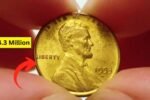A Hidden Treasure in Your Wallet
Imagine finding a $5 bill in your pocket worth thousands. The 1953 Red Seal $5 bill is catching attention in 2025 because some of these old notes are worth a fortune. These bills, known as United States Notes, have red ink for the seal and serial numbers, unlike the green ones used today. Printed in limited numbers, especially in top condition, they’re a collector’s dream. A 1963 Red Seal $5 bill recently sold for over $12,000, showing how valuable these can be. Check your old cash or family keepsakes, you might have a gem.
Why These Bills Are Special
The 1953 Red Seal $5 bill stands out because it was part of a smaller print run than modern bills. Back then, the U.S. used red seals before switching to green in later years. These bills feature Abraham Lincoln on the front and the Lincoln Memorial on the back. Collectors love them for their history and rarity, especially if they have unique features. Low serial numbers, like A00000001A, or star notes, marked with a star in the serial number, are the most valuable. Uncirculated bills, looking almost new, can fetch up to six figures.
How to Spot a Valuable Bill
Checking for a rare 1953 Red Seal $5 bill is easy if you know what to look for. First, find the serial number on the right side, printed in red ink. Low numbers, like A00000001A to A00000099A, are what collectors want. Look for a star in the serial number, these star notes replaced damaged bills and are super rare. Check the bill’s condition, uncirculated ones with no wear are worth the most. Use a magnifying glass to spot errors like misprints or ink smears, which can add value. Never clean the bill, as it can ruin its worth.
| Bill Feature | Description | Estimated Value |
|---|---|---|
| Low Serial Number | A00000001A to A00000099A | Up to $100,000+ |
| Star Note | Star in serial number | $500 to $20,000 |
What Makes Them Rare
The 1953 Red Seal $5 bills are rare because fewer were printed compared to today’s money. Many were used and worn out, leaving few in great shape. Star notes are even harder to find since they were made to replace defective bills. Printing errors, like double-printed numbers or misplaced seals, make some bills extra special. For example, a 1963 Red Seal $5 bill with a gutter error, a blank line across Lincoln’s portrait, sold for $51 in 2005. Collectors chase these quirks, driving up prices for bills with unique flaws.
| Error Type | Cause | Rarity |
|---|---|---|
| Gutter Error | Blank line across portrait | Very rare |
| Ink Smear | Ink spread on surface | Uncommon |
What to Do If You Find One
If you think you have a rare 1953 Red Seal $5 bill, handle it with care. Store it in a protective sleeve to avoid damage. Contact a grading service like PCGS or NGC to verify its condition and authenticity. They’ll grade it on a scale from 1 to 70, with 60 or higher meaning uncirculated. A professional grade can boost its value. Sell through a trusted auction house or dealer to get the best price. With millions of $5 bills out there, finding a rare one could change your life.
Start Your Treasure Hunt
Looking for these bills is like a fun game anyone can play. Next time you find old cash in a drawer or at a flea market, check for red seals. A 1953 $5 bill might be worth way more than its face value. With a sharp eye and some luck, you could uncover a piece of history that’s also a big payday. So, grab a magnifying glass and start searching today.



